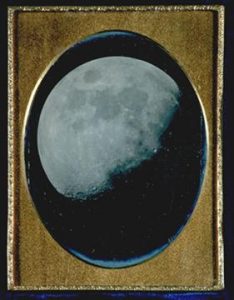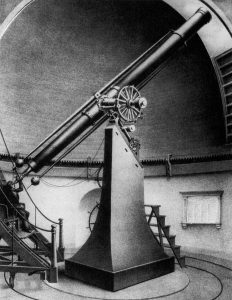
![]() In 1840, Edgar Allan Poe wrote a brief essay about the new photographic invention called the daguerreotype. This form of photography had been unveiled to the world in the previous year at a joint meeting of the French Academies of Art and Science. Given Poe’s fascination with the mysterious and horrific, it is surprising to find him praising the scientific applications of the new medium, including “the drawing of a correct lunar chart…since the rays of this luminary are found to be appreciated by the plate.”[footnote]Edgar Allan Poe, “The Daguerreotype,” in Alan Trachtenberg, ed., Classic Essays on Photography (New Haven: Leete’s Island Books, 1980), p. 5.[/footnote]
In 1840, Edgar Allan Poe wrote a brief essay about the new photographic invention called the daguerreotype. This form of photography had been unveiled to the world in the previous year at a joint meeting of the French Academies of Art and Science. Given Poe’s fascination with the mysterious and horrific, it is surprising to find him praising the scientific applications of the new medium, including “the drawing of a correct lunar chart…since the rays of this luminary are found to be appreciated by the plate.”[footnote]Edgar Allan Poe, “The Daguerreotype,” in Alan Trachtenberg, ed., Classic Essays on Photography (New Haven: Leete’s Island Books, 1980), p. 5.[/footnote]

A little over a decade later, the team of John Adams Whipple, a Boston daguerreotypist, and George P. Bond, son of the head of the Harvard Observatory, successfully produced detailed daguerreotypes of the moon. This was a complicated process. Since the moon and the Earth are in motion relative to each other, either very short exposures or a tracking device are necessary to avoid blurring the subject. Using Harvard’s “Great Refractor,” at that time the largest telescope in the world, they spent three years overcoming numerous technical, logistical, and meteorological challenges before they produced their first detailed images. As the author of the logbook for the telescope noted, the results gave “a better representation of the Lunar surface than any engraving of it that I have ever seen.”[footnote]M. Susan Barger, “The Moon, 6 August 1851,” The Christian A. Johnson Memorial Gallery Annual Report for the Year 1989 (Middlebury: Middlebury College, 1989), n.p.[/footnote] Just as photographs would be used to visually map the American frontier, photographs like this one were seen as more accurate maps of the lunar surface.
![]() In 1851, one of their lunar images was shown at the Crystal Palace exhibition in London, where it generated great excitement among the European scientific community. The Whipple-Bond team also made daguerreotypes of a partial solar eclipse, the star Vega, and the double star Castor. Their dedication and perseverance paved the way for the union of art and science that has inspired much subsequent astronomical imaging, especially the remarkable images produced from data gathered by the Hubble Space Telescope.
In 1851, one of their lunar images was shown at the Crystal Palace exhibition in London, where it generated great excitement among the European scientific community. The Whipple-Bond team also made daguerreotypes of a partial solar eclipse, the star Vega, and the double star Castor. Their dedication and perseverance paved the way for the union of art and science that has inspired much subsequent astronomical imaging, especially the remarkable images produced from data gathered by the Hubble Space Telescope.